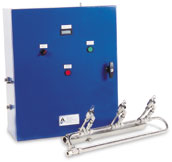

Armstrong Cool-Fog Systems use both compressed air and pressurized water to achieve atomization. Pressurized water is injected in the discharge orifice of a compressed air system. As the compressed air is discharged through an orifice, the air’s potential energy is converted to kinetic energy, which is imparted to the injected water.
The rapidly moving mixture experiences pressure fluctuations and eddy currents, which break up the water stream into atomized water particles. The mixture of atomized water and expanding air is discharged through an orifice and deflected off a resonator tip, which further reduces the water particle size and spreads the atomized water and air mixture. (See drawing.) The final product is fog.
Armstrong currently manufactures and markets the following systems for environmental-control applications:
Armstrong Cool-Fog Systems use both compressed air
and pressurized water to achieve atomization. Pressurized water is
injected in the discharge orifice of a compressed air system. As the
compressed air is discharged through an orifice, the air’s potential
energy is converted to kinetic energy, which is imparted to the injected
water.
The rapidly moving mixture experiences pressure
fluctuations and eddy currents, which break up the water stream into
atomized water particles. The mixture of atomized water and expanding
air is discharged through an orifice and deflected off a resonator tip,
which further reduces the water particle size and spreads the atomized
water and air mixture. (See drawing.) The final product is fog.
Armstrong currently manufactures and markets the following systems for environmental-control applications:
For help in specifying the exact model you need, download the product literature.
No PDF available for download.
No PDF available for download.
No PDF available for download.
Copyright © 2025 Campbell-Sevey, Inc.